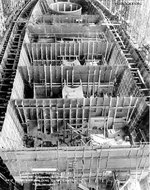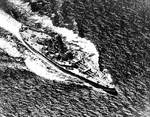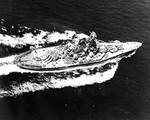South Dakota
| Country | United States |
| Ship Class | South Dakota-class Battleship |
| Hull Number | BB-57 |
| Builder | New York Shipbuilding Corp., Camden, New Jersey, United States |
| Laid Down | 5 Jul 1939 |
| Launched | 7 Jun 1941 |
| Commissioned | 20 Mar 1942 |
| Decommissioned | 31 Jan 1947 |
| Displacement | 35,000 tons standard; 43,200 tons full |
| Length | 680 feet |
| Beam | 108 feet |
| Draft | 36 feet |
| Speed | 28 knots |
| Crew | 2,364 |
| Armament | 9x406mm guns, 16x127mm guns, 68x40mm guns, 76x20mm guns |
Contributor: C. Peter Chen
ww2dbaseSouth Dakota was commissioned in 1942 with Captain Thomas L. Gatch in command. After fitting out at Philadelphia, Pennsylvania, United States, she held her shakedown cruise from 3 Jun to 26 Jul, then headed out for the Pacific Ocean on 16 Aug. She reached the Panama Canal on 21 Aug, then arrived at Nuku?alofa, Tonga, on 4 Sep. On 6 Sep, she struck a coral pinnacle in the Lahai Passage, and had to sail for Pearl Harbor Navy Yard, Hawaii, United States for repairs, which lasted until 12 Oct.
ww2dbaseSouth Dakota sailed with Task Force 16, which was centered around carrier Enterprise, from Hawaii to Espiritu Santo, New Hebrides, where they joined with Task Force 17 to form Task Force 61, commanded by Rear Admiral Thomas C. Kinkaid. On 25 Oct, she was engaged in the Battle of Santa Cruz Islands, where she acted as an anti-aircraft gun platform. She was attacked by dive bombers and sustained a 500-pound bomb hit on the top of her number one turret. At the end of the battle, she was credited with downing 26 Japanese aircraft.
ww2dbaseOn 30 Oct, South Dakota collided with destroyer Mahan while avoiding a submarine contact. Both ships sailed to Nouméa, New Caledonia for repairs by USS Vestal.
ww2dbaseOn 11 Nov, South Dakota sailed for Guadalcanal with Task Force 16. On 13 Nov, she joined Task Force 64 under Rear Admiral Willis A. Lee. During the evening of 14 Nov 1942, a Japanese fleet consisted of battleship Kirishima, heavy cruiser Atago, heavy cruiser Takao, light cruisers, and destroyers was detected by submarine Trout, and Task Force 64 was dispatched to respond. By 2210, Vice Admiral Nobutake Kondo had also detected Task Force 64, and divided his force into three sections in an attempt to out maneuver the Americans. Battleships South Dakota and Washington opened fire on light cruiser Sendai at 2317, but at 2333 South Dakota ran into electrical problems which put much of her electronics out of commission, depriving the Americans the use of her radar. Meanwhile, Lee made the realization that his destroyer screen was about to be wiped out completely. He ordered South Dakota to go around the sinking destroyers to shield them from some fire, meanwhile allowing her to fire a few more rounds of broadside fire on Sendai before retiring. At 2348, South Dakota completed this maneuver, and turned starboard again to exit the battle, only to find that she was ambushed by another Japanese group, which she had not detected because of the lack of radar. 34 torpedoes were fired from the ambushing ships at 2355, but all of them missed. The torpedoes were followed by a hail of gunfire from battleships Kirishima, Atago, and Takao. Battleship Washington moved close to support by firing on Kirishima, but the Japanese ships were determined to destroy South Dakota first and refused to be distracted. Washington fired 75 16-inch shells at Kirishima, scoring 9; there were 40 hits by the smaller 5-inch shells, too. Kirishima quickly became a burning wreck by 0012. South Dakota, by this point, fared only a little better; almost everything on the topside was destroyed after being hit by 42 shells, leaving her without any capability for communications. Lee, with his flag bridge aboard Washington, only hoped that the lack of communications from South Dakota only meant she was retiring from battle, not sinking. Luckily for South Dakota, the Japanese fleet retired from the Second Naval Battle of Guadalcanal, largely because Washington was inflicting so much damage on Kirishima, which would eventually be scuttled due to the damage received. South Dakota retired to Nouméa for temporary repairs by USS Prometheus, and then sailed for New York City, New York, United States for permanent repairs, arriving on 18 Dec 1942.
ww2dbaseSouth Dakota returned to service on 25 Feb 1943. In mid-Apr, she was deployed to carrier Ranger's group to the North Atlantic. Until 1 Aug, she operated with the British Home Fleet based at Scapa Flow, Scotland, United Kingdom. In Aug, she sailed for the United States.
ww2dbaseOn 21 Aug 1943, South Dakota sailed for the Pacific Ocean again, arriving in Fiji on 7 Nov. On 11 Nov, she joined Task Group 50.1 for Operation Galvanic, the invasion of the Gilbert Islands. She escorted carriers as their aircraft struck targets in the Gilbert and Marshall Islands. On 8 Dec, she bombarded Nauru Island. On 30 Jan 1944, she bombarded Roi and Namur in the Marshall Islands, and then supported the amphibious landings at the Marshall Islands over the following days. Between 17 and 18 Feb, she escorted carriers as they struck the Japanese garrison of Truk in the Caroline Islands. On 24 Feb, she escorted carriers as the aircraft struck the Mariana Islands for the first time in the war; during this attack, South Dakota shot down four Japanese aircraft. Between 22 Mar and early Apr, she escorted carriers as they struck Palau, Yap, Woleai, and Ulithi in the Caroline Islands. On 29 and 30 Apr, she escorted carriers during another strike on Truk, and then fired her guns on Japanese installations on the island. On 1 May, she bombarded Ponape Island, Caroline Islands. On 13 Jun, she bombarded Tanapag Harbor, Saipan for six hours in support of the invasion.
ww2dbaseShortly after 1000 on 19 Jun 1944, the first of many waves of Japanese aircraft were detected, starting the Battle of the Philippine Sea. At 1049, South Dakota was struck by a 250-kg bomb on the main deck, blowing a large hole but did not cause structural damage, although 24 men were killed and 27 were wounded. The battle would subsequently come to be known a the "Great Marianas Turkey Shoot" for the massive losses the American forces would inflict on the Japanese. South Dakota retired to Ulithi on 27 Jun, and headed to Puget Sound Navy Yard on the west coast of the United States, arriving on 10 Jul.
ww2dbaseAfter the overhaul at Puget Sound was complete, South Dakota returned to Ulithi in Sep 1944. Between Oct and Dec, she operated east of the Philippine Islands, screening for carriers that launched strikes at Manila and other targets on Luzon Island as an indirect support for the invasion of Mindoro, Philippine Islands. Between 30 Dec 1944 and 26 Jan 1945, she continued to escort carriers and they launched aircraft against Taiwan, Luzon, Hong Kong, Hainan, and Okinawa. On 17 Feb, South Dakota escorted carriers during a strike on Tokyo, Japan. On 19 and 20 Feb, she operated off of Iwo Jima. In Mar and Apr, she bombarded southeastern Okinawa.
ww2dbaseOn 6 May 1945, a tank of high capacity powder aboard South Dakota exploded, killing three men instantly and then another eight later due to injuries. She retired to Guam in the Mariana Islands on 11 May for temporary repairs. In Jul, while escorting carrier strikes on Japan, she bombarded the Kamaishi Steel Works at Kamaishi, Honshu, Japan on 14 Jul. On 29 and 30 Jul, she bombarded Hamamatsu, Honshu. On 9 Aug, she bombarded Kamaishi once again. She remained in the area to screen for carriers until Japan surrendered on 15 Aug.
ww2dbaseOn 27 Aug 1945, South Dakota entered Sagami Wan (Bay) at Honshu. Two days later, she entered Tokyo Bay. She left Japan on 20 Sep, arriving at San Pedro, California, United States in late Oct 1945. After the war, she was placed in reserve in early 1947, and was never reactivated again. She was sold to Lipsett Division, Luria Brothers and Company, Inc. for scrap at the cost of US$446,000.
ww2dbaseSources: Struggle for Guadalcanal, Wikipedia.
Last Major Revision: Sep 2008
Battleship South Dakota (BB-57) Interactive Map
Photographs
 |  |  |  |
Maps
 |
South Dakota Operational Timeline
| 5 Jul 1939 | The keel of the battleship USS South Dakota (BB-57) was laid down at the New York Shipbuilding Corporation shipyard in Camden, New Jersey, United States. |
| 20 Mar 1942 | South Dakota was commissioned into service. |
| 25 Jul 1942 | As USS Nicholas escorted USS South Dakota from Casco Bay, Maine to the Delaware Capes, she made a sound contact and dropped 5 depth charges with no observable results. These were Nicholas’s first shots of the war. |
| 26 Oct 1942 | At the Battle of Santa Cruz Islands, US forces achieved victory but saw USS Enterprise, USS South Dakota, and USS San Juan damaged. Aircraft carrier USS Hornet (Yorktown-class) was badly damaged from aerial bombs and torpedoes and then finally hit by three Type 93 torpedoes launched from Japanese destroyers Akigumo and Makigumo which caused her to sink 30 minutes later. On the Japanese side, carriers Shokaku and Zuiho were damaged by dive bombers from USS Hornet and USS Enterprise, respectively. |
| 28 Oct 1942 | Destroyer USS Shaw transferred survivors of USS Porter to battleship USS South Dakota while en route Efate in the New Hebrides. |
| 31 Oct 1943 | Battleships USS Washington, USS Massachusetts, and USS South Dakota escorted by destroyers USS Nicholas, USS Fletcher, USS LaVallette, USS Jenkins, and USS Taylor departed Efate New Hebrides to rendezvous with a carrier task group. |
| 2 Nov 1943 | Battleships USS Washington, USS Massachusetts, and USS South Dakota escorted by destroyers USS Nicholas, USS Fletcher, USS LaVallette, USS Jenkins, and USS Taylor rendezvoused and joined with carriers USS Essex, USS Bunker Hill, and USS Independence with battleships USS Alabama, USS Indiana, USS Tennessee, USS Maryland, and USS Colorado and cruisers USS Portland, USS Mobile, USS Santa Fe, and USS Birmingham with destroyers USS Taylor and USS Radford. Together, this task group steamed toward Nandi Bay, Fiji. |
| 7 Nov 1943 | Carriers USS Essex, USS Bunker Hill, and USS Independence with battleships USS Washington, USS Massachusetts, USS South Dakota, USS Alabama, USS Indiana, USS Tennessee, USS Maryland, and USS Colorado with cruisers USS Portland, USS Mobile, USS Santa Fe, and USS Birmingham escorted by destroyers USS Nicholas, USS Fletcher, USS LaVallette, USS Jenkins, USS Taylor, and USS Radford arrived at Nandi Bay, Fiji. |
| 11 Nov 1943 | Battleships USS Washington, USS Indiana, USS South Dakota, and USS Massachusetts escorted by destroyers USS Nicholas, USS Fletcher, USS LaVallette, USS Jenkins, USS Taylor, and USS Radford departed Nandi Bay, Fiji bound for the Marshall Islands. |
| 18 Dec 1944 | Many ships from the United States Third Fleet, Task Force 38 sailed into Typhoon Cobra in the Philippine Sea. Three destroyers and 790 men were lost. |
| 14 Jul 1945 | American battleships USS South Dakota, USS Indiana, and USS Massachusetts and escorting destroyers bombarded Kamaishi, Honshu, Japan; the primary target was the Kamaishi Works of the Japan Iron Company, but several destroyers shells overshot the target and hit the town, killing many civilians; battleship shells were more accurate, destroying about 65% of the industrial complex, but they also killed many civilians; this was the first time the Japanese home islands were subjected to naval bombardment. To the north, the sinking of 6 warships and 37 steamers on the ferry route between Honshu and Hokkaido islands effectively cut off the latter from the rest of the home islands. At Kure in southern Japan, aircraft of US Navy TF 38 damaged carrier Amagi, carrier Katsuragi, and battleship Haruna; at Misawa in northern Japan, G4M bombers that were assigned to partake the planned Operation Ken, which sought to deliver 300 suicide commandos to the Mariana Islands, were destroyed (the American would not know of Operation Ken until after the war). The carriers were escorted by a large naval force that included battleship USS Missouri. Far to the south, the USAAF XXI Bomber Command canceled a long-range P-51 raid from Iwo Jima to attack Meiji and Kagamigahara near Nagoya due to poor weather. |
| 31 Jan 1947 | South Dakota was decommissioned from service. |
Did you enjoy this article or find this article helpful? If so, please consider supporting us on Patreon. Even $1 per month will go a long way! Thank you. Share this article with your friends: Stay updated with WW2DB: |
Visitor Submitted Comments
1 May 2010 04:34:54 AM
My Dad served as a Marine aboard the USS South Dakota during World War 2 I am looking for anyone that may have known him. His name was Gerald B. O'Reilly and came from Brockton, Massachusetts.
12 Jun 2010 04:27:16 PM
My father was the Chaplain on the South Dakota
in 1944-1945. He passed away in 1961, he had attained the rank of Captain. He had a scrapbook of many pictures taken of ships personnel, including many Marines. I donated these pictures to the museum in Sioux Falls.
29 May 2011 06:29:46 PM
I am the very proud som of Sterling Gregory. My dad was born on 8/30/1923 in Gadsen County, Florida. He was raised in a home with 2 brothers and 2 sisters mom and dad. They had no tv, no electric, no phone, no car. But some how he went to school and made it through the 12th grade. On 2/14/1941, he signed up for the Navy, his first paying job. But I know he did not know what he was getting into. After boot camp the Navy sent him to a ship but would not tell him her name. To him that was strange, but he went. Coming from a town called Sumatra Fl, with 35 men women and kids to a ship bigger than the town, that was scary. When he reported to the ship, he was greeted with welcome to the Battle Ship X. My dad was the eye of this ship. He was a radar man that communicated with Lt. Sergeant Shriffer. I believe if it wasnt for the radar men, the crew may not have had time to do the great job they had to do and did it well. My dad was aboard the USS South Dakota start to finish. He was let go from the navy on 1/31/1962 because of a heart attack and died 2/13/1992 still all navy. E7 Chief Gregory was baried in Sumatra Florida with a slab of granet with a carving of the USS South Dakota with the anker down. God bless all the crew and the 2nd and 3rd generation. From one of the biggest navy brats the navy has ever seen, I want to take the opportunity to thank all of the branches of the service, living or dead, for serving our country and looking out for me. God bless everyone of you. Thank you, Jimmy Gregory. hopalong36@yahoo.com
12 Mar 2013 11:04:18 PM
is the ship saank or what
10 Jun 2013 12:44:57 PM
I bought a US Navy Kabar knife last week.
On the back of the sheath was scratcher the inatials E.B.K- Uss South Dakota.
Does anyone remember E.B.K ?
Any help would be appreciated.
VL
Thanks to the greatest generation, we are a free people.
1 Aug 2014 01:42:33 PM
Gerald O'Reilly from Brockton was my grandfather
2 Nov 2015 03:01:13 PM
I just read a book called "The Terrible Hours." about the sinking, crew rescue and and raising of the submarine USS Squalus in 1939. The crew of that sub were the very first men to ever be rescued from a sunken US Navy sub. They were raised from a depth of 200 feet using a diving sphere that was designed, developed, and tested by a Navy man named Charles "Swede" Momsen who was Captain of USS South Dakota from December 1944 to August 1945. He discovered through meticulous testing that the powder explosion which is noted above was actually caused by static electricity generated by the gun powder's metal container's silk lining rubbing the inside of the container as the containers were moved. For anyone interested in History "The Terrible Hours," by Peter Maas is an incredible read.
2 Nov 2015 03:02:25 PM
cool kid the South Dakota was sold for scrap in 1947
All visitor submitted comments are opinions of those making the submissions and do not reflect views of WW2DB.
» Guadalcanal Campaign
» Solomon Islands Campaign
» Gilbert Islands Campaign
» Marshall Islands Campaign
» Mariana Islands Campaign and the Great Turkey Shoot
» Philippines Campaign, Phase 1, the Leyte Campaign
» Typhoon Cobra
» Raid into the South China Sea
» Okinawa Campaign
» Preparations for Invasion of Japan
» Japan's Surrender
 |
- » 1,146 biographies
- » 336 events
- » 43,422 timeline entries
- » 1,237 ships
- » 349 aircraft models
- » 207 vehicle models
- » 372 weapon models
- » 123 historical documents
- » 259 facilities
- » 468 book reviews
- » 28,395 photos
- » 432 maps
George Patton, 31 May 1944
Please consider supporting us on Patreon. Even $1 a month will go a long way. Thank you!
Or, please support us by purchasing some WW2DB merchandise at TeeSpring, Thank you!
6 Nov 2006 09:29:06 AM
The main armament for BB-57 was 1645 NOT 1650..... The latter (which ended up on Iowa-class) were slated for earlier BB-49, which ultimately wasnt built.